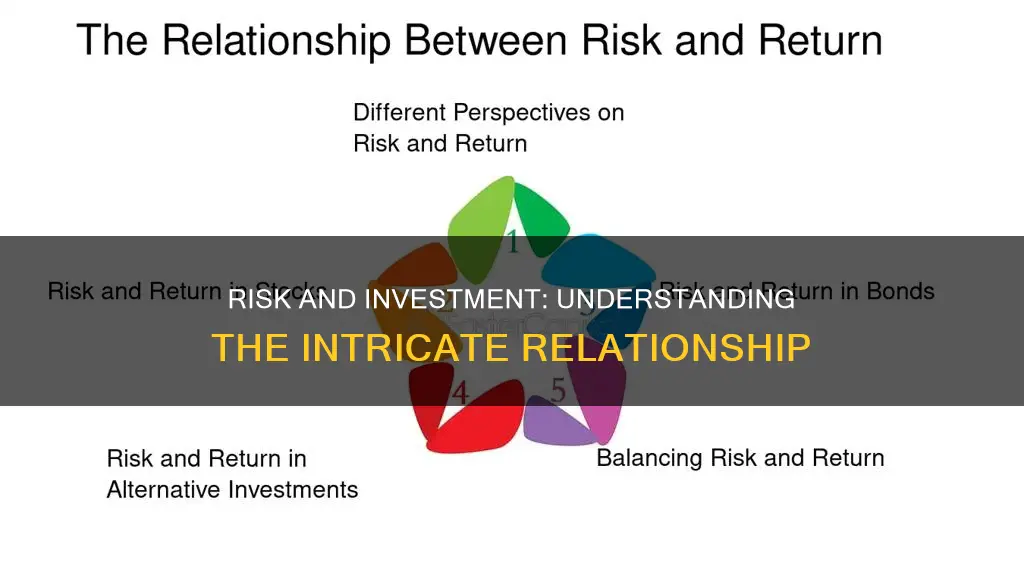
Risk and investment are closely intertwined concepts. Risk, in financial terms, refers to the degree of uncertainty and potential financial loss associated with an investment decision. All investments carry some level of risk, and this risk can manifest in various forms, such as market risk, business risk, liquidity risk, and concentration risk. The possibility of losing money is ever-present in investing, and it is essential to understand and manage these risks effectively. The relationship between risk and return is fundamental in finance, with higher risks typically leading to higher potential returns. Investors need to be compensated for taking on additional risk, and their willingness to take risks depends on their risk tolerance, which is influenced by factors such as personality, lifestyle, and age, and financial goals.
| Characteristics | Values |
|---|---|
| Definition of Risk | The chance that an investment's actual gains will differ from an expected outcome or return. |
| Risk and Return Relationship | As risk increases, investors expect higher returns to compensate for the risk. |
| Risk and Time | The longer the investment horizon, the more risk an investor can afford to take. |
| Risk and Diversification | Diversification can help reduce risk by spreading investments across different asset types and industries. |
| Risk Measurement | Risk is often assessed by considering historical behaviours and outcomes. Standard deviation is a common metric to quantify risk. |
| Risk Management | Strategies such as hedging, asset allocation, and insurance products can help manage risk. |
| Risk Tolerance | An investor's risk tolerance depends on their personality, lifestyle, age, financial status, and goals. |
| Types of Risk | Systematic Risk, Unsystematic Risk, Business Risk, Operational Risk, Legal Risk, Credit Risk, Country Risk, Foreign-Exchange Risk, Interest Rate Risk, Reinvestment Risk, Political Risk, Counterparty Risk, Liquidity Risk, Model Risk. |
What You'll Learn
- Risk and return are linked: the higher the risk, the higher the potential return
- Risk and time horizons: the longer the investment time, the higher the potential risk
- Types of financial risk: systematic and unsystematic
- Risk and diversification: diversifying investments can reduce risk
- Credit or default risk: the risk of a borrower defaulting on their debt obligations

Risk and return are linked: the higher the risk, the higher the potential return
Risk and return are inextricably linked. The higher the risk, the higher the potential return. This is known as the risk-return tradeoff.
The risk-return tradeoff is an investment principle that indicates that the higher the risk, the higher the potential reward. It is a positive correlation between the amount of risk and the potential for return. A lower-risk investment generally has a lower potential for profit, while a higher-risk investment has a higher potential for profit but also a higher potential for loss.
For example, a US Treasury bond is considered a safe investment and therefore has a lower rate of return when compared to a corporate bond, which has a higher default risk. Investors need to be compensated for taking on additional risk, so they are offered a higher rate of return.
The risk-return tradeoff is a fundamental concept in finance and is one of the essential components of decision-making for investors. They use it to assess their portfolios as a whole and to determine the appropriate levels of risk and reward.
It is important to note that higher risk does not always equate to higher returns. There is no guarantee that taking greater risk will result in a greater return. The risk-return tradeoff simply indicates that higher-risk investments have the possibility of higher returns.
Equity and Investment Trust: What's the Difference?
You may want to see also

Risk and time horizons: the longer the investment time, the higher the potential risk
Risk and investment are closely related. Risk is defined in financial terms as the chance that an investment's actual gains will differ from the expected outcome or return. In other words, risk includes the possibility of losing some or all of an original investment.
The amount of risk an investor is willing to take on is a big part of why they can potentially earn returns that exceed what they would get for holding cash. This is known as the "equity risk premium". Generally, as investment risks rise, investors expect higher returns to compensate for taking those risks.
The time horizon of an investment is the period of time one expects to hold an investment until they need the money back. This is largely dictated by investment goals and strategies. For example, saving for a down payment on a house, for maybe two years, would be considered a short-term time horizon, while saving for retirement would be a long-term time horizon.
The longer the time horizon, the more aggressive or riskier an investor can be in their portfolio. This is because the longer the time horizon, the more time there is to recover from any losses. Longer-term investors can allocate a larger portion of their portfolio to higher-risk investments, like stocks, than shorter-term investors.
However, it is important to note that higher risk does not automatically equate to higher returns. While higher-risk investments have the possibility of higher returns, there are no guarantees.
Therefore, it is crucial for investors to carefully evaluate their own goals, risk tolerance, and investment timeline before deciding where to put their money.
India's Investment in Chabahar: Exploring Strategic Interests
You may want to see also

Types of financial risk: systematic and unsystematic
Risk is defined in financial terms as the chance that an investment's actual gains will differ from the expected outcome or return. In other words, it is the possibility of losing some or all of an original investment. All investments involve some degree of risk.
Financial theory classifies investment risks affecting asset values into two categories: systematic risk and unsystematic risk.
Systematic Risk
Systematic risk, also known as market risk, affects the overall market, not just a particular stock or industry. It is unpredictable and difficult to avoid. Sources of systematic risk include inflation, interest rates, wars, recessions, currency changes, market crashes, and downturns. It is largely due to changes in macroeconomics and can be mitigated through hedging or by using the correct asset allocation strategy.
Unsystematic Risk
Unsystematic risk, also known as specific risk or idiosyncratic risk, is a category of risk that only affects a specific industry or company. It is the risk of losing an investment due to company or industry-specific hazards. Examples include changes in management, product recalls, regulatory changes, and new competitors. Unsystematic risk can be mitigated through diversification.
Total Risk
Total risk is the sum of systematic and unsystematic risk. While systematic risk cannot be avoided through diversification, unsystematic risk can be.
Investing While Saving for a Home: Wise or Risky?
You may want to see also

Risk and diversification: diversifying investments can reduce risk
Risk and investment are closely related concepts. Risk, in financial terms, is the chance that an investment's actual gains will differ from the expected outcome or return. Risk also includes the possibility of losing some or all of the original investment.
Diversification is a key strategy for managing risk and enhancing the potential for returns. By spreading investments across various asset classes, sectors, industries, and geographical regions, investors can reduce their exposure to any single risk factor or market fluctuation. This is often likened to the idea of not putting all your eggs in one basket.
The benefits of diversification include reducing the volatility of an investment portfolio, providing a safeguard against significant financial loss, and offering the potential for more stable and consistent returns over time. A well-diversified portfolio is also less likely to suffer adverse effects from a poorly performing investment.
There are several ways to achieve diversification:
- Spread your investments across different asset classes such as stocks, bonds, cash, real estate, commodities, and derivatives.
- Diversify within each asset class. For example, within stocks, invest in a range of sectors such as technology, healthcare, and finance. Within bonds, include a mix of government, municipal, and corporate bonds.
- Include securities that vary in risk. This ensures that large gains offset losses in other areas.
- Regularly review and rebalance your portfolio to ensure it aligns with your financial strategy, goals, and risk tolerance.
While diversification can help mitigate risk, it's important to note that it cannot eliminate risk entirely. Over-diversification can also dilute potential returns and increase costs and administrative burdens. Therefore, it's crucial to find a balance that aligns with your investment goals and risk tolerance.
Unlocking Investment Opportunities with Home Equity
You may want to see also

Credit or default risk: the risk of a borrower defaulting on their debt obligations
Credit risk, or default risk, is the risk that a borrower will be unable to pay the interest or principal on their debt obligations. Default risk is a sub-category of credit risk, and it applies to all forms of credit offerings, including loans, bonds, and credit cards. This type of risk is particularly concerning for investors who hold bonds in their portfolios.
The default risk posed by borrowers can be assessed using standard measurement tools. For consumers, this includes FICO credit scores, while for companies and governments, independent credit ratings from agencies like Standard & Poor's, Moody's, and Fitch are used. These credit ratings consider the business and financial risks of the borrower and provide guidance to lenders on their creditworthiness, or how likely they are to default on their payments.
There are two main drivers of default risk: business risk and financial risk. Business risk assesses external and internal factors that can impact the borrower, including country-specific risks such as economic and political changes, industry-specific risks such as market structure and growth trends, and company-specific risks such as competitive dynamics and management quality. Financial risk, on the other hand, involves a quantitative and qualitative assessment of the borrower's ability to service and repay loans, taking into account factors such as cash flows, liquidity, earnings, and asset quality.
Lenders compensate for higher levels of default risk by charging increased interest rates on loans. A higher default risk generally leads to higher interest rates, as investors demand greater returns to compensate for the elevated risk. As a result, borrowers with high default risk may struggle to access capital markets and secure funding.
Overall, understanding and managing credit or default risk is crucial for investors and lenders. By assessing a borrower's capacity to make timely debt payments, lenders can make informed decisions about whether to extend credit and at what interest rate.
Illiquid Investments: Which Portfolio Has the Least Liquidity?
You may want to see also
Frequently asked questions
Risk and investment are related because all investments carry some degree of risk. Risk refers to the degree of uncertainty and the potential financial loss inherent in an investment decision. The higher the risk, the higher the potential return.
The level of risk associated with an investment or asset class typically correlates with the level of return that investment might achieve. Investors who take on risky investments and potentially lose money are rewarded for their risk. Therefore, investors seek higher returns to compensate for higher risks.
Investors can manage risk by understanding the basics of risk and how it is measured. They can also use strategies such as diversification and hedging to reduce risk. Additionally, individuals can determine their risk tolerance, which is influenced by their past experiences, current financial status, and future goals, to make investment decisions that are right for them.







